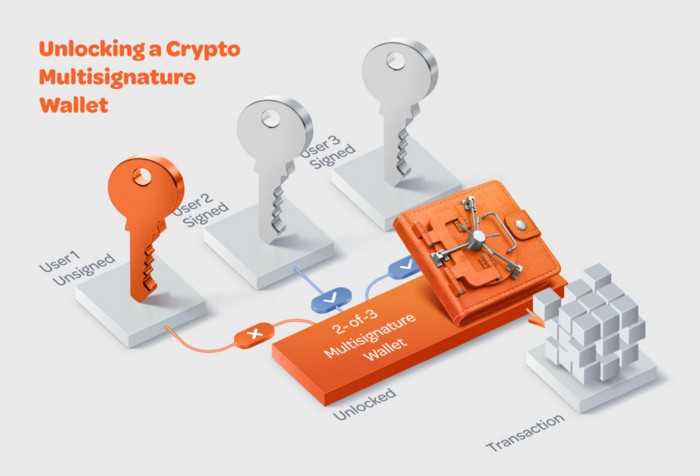What is Multisig? What is Key Management in Crypto?

Introduction to Encryption and Digital Signatures
Digital signatures use mathematics and cryptography to validate the authenticity of messages and digital documents. They are just like handwritten signatures, but they offer a lot more in-built security and flexibility. Digital signatures are used to authenticate the origin, identity, and status of electronic communications, transactions, documents, or messages, and they help us overcome issues related to tampering and impersonation in the digital sphere.
Here is how they work.
An algorithm — a mathematical formula — is used to create two keys that share a unique mathematical link. One of the keys is private, and the other is public. The person who digitally signs a document or sends a transaction uses the private key from the key pair to encrypt the data being transmitted or signed.
The only way to decrypt the transaction or message is with the corresponding public key of the key pair. Because of the way the mathematical rules of the encryption algorithm work, no other key pair will work, and it is nearly impossible for anyone to come up with the right private key to a corresponding public key either by chance, brute force, or otherwise.
As long as the private keys for a transaction, wallet, or document are kept safe, any digital signature related to that transaction, wallet, or document can be trusted.
What is Key Management? How Does it Work for Crypto Wallets?
Key management is an umbrella term which covers the management, i.e generation, storage, transferring, destruction, usage, replacement and any other maintenance activity of cryptographic keys (both public and private keys) in a cryptographic ecosystem.
Depending on the size of a given ecosystem, there can be thousands, millions, or even billions of public and private keys that are used to sign transactions and secure the wallets in which digital assets such as tokens or cryptocurrencies are stored. Without secure and effective key management, a cryptosystem cannot function safely and securely.
The ownership of digital assets comes down to the ownership of the private key that can unlock a crypto or digital wallet. Without a private key — which is required for creating the digital signature that can approve a transaction or prove ownership of a document or message — you cannot prove ownership of the asset, wallet, or document in question. This is why key management is so important. It is required for not only establishing asset ownership but for approving and signing transactions and securing wallets and the integrity of the overall system.
What is Multisig? What Are Multisig Wallets?
The only way you can send funds from a wallet is if you have the wallet’s private key. The private key is required to unlock, create, and sign a transaction that shows you are the owner of the funds in question and have the authority to manage the wallet in question and send funds from it.

Multisig is simply a type of wallet that requires more than one signature — i.e., uses more than one private key to encrypt signature-related data. With single-signature wallets, a single digital signature that is generated by a wallet’s private key is enough to execute a transaction. With multisig wallets, multiple signatures (determined by the system) that are generated by multiple private keys are required to approve and/or execute transactions. This adds an additional layer of security to your funds.
By adding multi-sig functionality to a system, enterprises can make it exponentially harder for a would-be malicious actor to execute unapproved transactions or access the funds of other users.
Unido’s Proprietary Multisig Key Management System
Unido’s proprietary multi-sig key management technology is powered by Unido Core, a proprietary key management and transaction signing technology. It uses an innovative private key obfuscation algorithm that breaks up private keys and securely encrypts and shares the key with multiple users. This reduces the chances of the key being lost or stolen, and it allows multiple members of a wallet or account to approve or refuse transactions, as needed. Transactions from a given wallet can only be authorized/executed if/when a group of clients who share a wallet hold enough private key fragments to authorize the transaction.
Unido’s fragmented key signing engine brings unmatched security to a growing marketplace that currently does not have the enterprise-grade security demanded by clients.
How Unido’s Key Management System Will Help
By using key fragmentation as a cornerstone of key management, Unido ensures that on-chain assets can only be accessed by permitted parties. However, the system has been designed for use by not just technical but non-technical personnel as well. It adds enterprise-grade security to any system via an intuitive API that can connect wallets, services, networks, and more to Unido and creates a gateway for different systems to interact with and use Unido’s financial services and management tools, but it also makes it easy to integrate legacy systems with blockchain-powered decentralized applications.
Unido’s key management system also works with multiple on-chain use cases. This type of seamless interoperability and easy integration are critical for DeFi applications to onboard users and reach critical mass.
Unido Core — The Heart of Unido EP
Unido Core, the Unido Core API, key fragmentation technology, and secure, effective key management are all critical components of the Unido ecosystem that make it easy yet safe for enterprises to connect to and interact with DeFi platforms and investments. Without these services, the onboarding of new users to the DeFi space would be slow and ineffective, but as part of Unido’s mission of bringing enterprises to decentralized capital markets, Unido is quickly and effectively bridging these gaps.
Learn more about the Unido suite of DeFi applications at https://www.unido.us/.